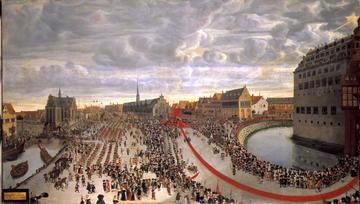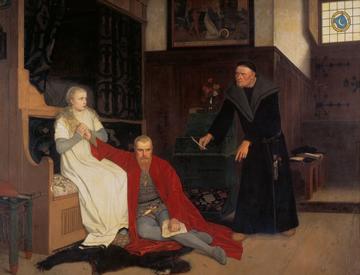Informal Counsellors as Royal Agents in Early Modern Parliaments
In September and October 1660, Christoffer Gabel was running back and forth between the Danish king Frederik III, who usually resided in Rosenborg Castle, the estates meeting in Copenhagen on Slottsholmen, and the city hall where the mayor, Hans Svane, resided. Since I was just in Copenhagen with its wide streets and generous city architecture, I can confirm that Gabel surely got in his 10,000 steps per day during these turbulent weeks after the devastating defeat against Sweden in two wars, from 1657 to 1658, and 1658 to 1660. Christoffer Gabel’s mission was to find a way out of a political, financial, and economic mess, and to make the best out of this moment of general uncertainty for royal politics.

Map of early modern Copenhagen with Parliament, Castle Rosenborg, and City Hall marked, made by J. F. Arnoldt in 1728, Wikimedia Commons.
The second war against Sweden, which had ended in May 1660 with the treaty of Copenhagen, did lessen the burden of the hated treaty of Roskilde (1658) in which Denmark had to concede large parts of their Baltic empire to Sweden, including Scåne which had enabled them for centuries to control both sides of the Sound, the only sensible strait into the Baltic Sea with its important grain and timber ports. However, Denmark still lost, and not only had to make payments to Sweden but also to rebuild their own community. The king trusted his informal counsellor to help him solve these problems, even though Gabel came neither from an aristocratic nor a clerical background, the usual career way for a political advisor. And Christoffer Gabel’s work paid off: he managed to get the estates meeting in parliament on board with the king’s and his own plan to establish a hereditary monarchy and give Denmark an absolutist constitution – the only such constitution in Christendom. This constitution survived even more wars with Sweden, a mentally ill king, a royal daughter with uncertain paternity, Danish colonial expansion, several court intrigues, political unrest, Napoleon, British bullying and bombardments of Copenhagen, and the loss of Norway, until it was finally abolished in the 1848 revolutions sweeping across Europe. For nearly 200 years, Denmark had an absolutist constitution, and it all started with an informal counsellor acting on behalf of the king as intermediary to the Danish parliament and the institutions of Copenhagen.

Painting of Homage to Frederik III by Wolfgang Heimbach in 1666, Wikimedia Commons.
Not nearly such a success story occurred in the 1560s in Sweden with Erik XIV and Jöran Persson. Again, an informal counsellor from a non-aristocratic and non-clerical background, Jöran Persson, acted as mediator on behalf of his king with the Swedish parliament. This particular parliament was a meeting of all estates – peasants, miners, burghers, clerics, and aristocracy from all Swedish provinces – in Stockholm and Uppsala in 1567. Membership of such a riksdag could vary, depending on topic, meeting place, meeting time, and so on, but this parliament had unusually high numbers, especially from among the peasantry, and unusually low numbers from the aristocracy who were mostly still fighting in Scåne against Denmark in the Nordic Seven-Years‘-War. Persson’s job was much hindered by the erratic behaviour of Erik who, at the same time Jöran tried to convince parliament to hold a formal court case against a few members of the aristocracy suspected of high treason, went ahead and killed most of the accused himself. Still, while Erik, after his bloody deed, ran into the woods trying to find his way back to sanity (and failing spectacularly, as his return in the borrowed clothes of a peasant and general disorientation three days later showed), Jöran Persson managed to convince the parliamentary meeting to declare a death sentence for the murdered aristocrats, in effect legitimizing Erik’s act after the fact. However, in the long-term Persson was not successful with these chaotic, shady, and highly unusual proceedings and happenings in the spring of 1567. After Erik XIV was imprisoned during a rebellion against him led by his half-brothers John (III) and Charles (IX), Jöran Persson was imprisoned as well, accused of abuse of power in these trials of 1567, and condemned to death. He was put on the execution wheel and suffered a brutal and slow death in September 1568. Erik XIV was officially deposed by a (strictly speaking illegal) parliament in January 1569, imprisoned, and died there in 1577 – probably poisoned, and probably on orders from his half-brother, now King John III.

The nineteenth-century imagination of the evil counsellor Jöran Persson urging Erik (seated) to sign the death warrant, while his innocent Mistress Karin Månsdottir looks shocked – as far from reality as possible, except maybe for the confusion on Erik’s face. Painting by Georg von Rosen, 1871, Wikimedia Commons.
Although Frederik III of Denmark, the first monarch of an absolutist constitution in Europe, was not deposed, Christoffer Gabel also did not keep his position after his king’s death in 1670. He lost all offices and titles, and died in exile in 1673. His protégé, Peder Schumacher, later count Griffenfeld, fared a bit better. Together with Gabel and on orders from Frederik III, Schumacher was the pen and the brains behind the absolutist constitution introduced as Lex Regia/Kongelov in 1665 which were accepted with the agreement of parliament – or at least that is what it says in the text.
Informal counsellors were essential, and often used by kings wanting political change and needing to influence important people and institutions. In the early modern period, with its increased importance and more stable establishment of parliaments, at least in Northern Europe, this meant that informal counsellors had to deal with these parliaments regularly. This was something that the monarch, usually not part of the parliamentary proceedings, could not do. Aside from parliaments, the royal court and the privy council (the råd in the Scandinavian kingdoms) determined policies, and counsellors trying to push through their monarch’s policies had to navigate these snake pits as well. Despite the Danish Lex Regia and the early modern idea of absolute monarchical power, in practice, no monarch could just realise his political wish list with a snap of the fingers. However, with the help of more flexible informal counsellors, they came close. The other side of the coin, however, was the nearly unavoidable fall of the counsellor, and – maybe – the destruction or reduction of everything achieved. The changes to government that Erik XIV and Jöran Persson introduced were abolished after 1569, Erik was deposed, and Jöran gained a reputation in Swedish historiography as an “evil counsellor”.
When parliaments first were called in the thirteenth century, monarchs wanted to get broader feedback and more widespread information from their realms. Also, they wanted more financial support in the form of taxes; in exchange, monarchs granted them the right to listen to their counsel. (Of course kings or queens did not need to adhere to this counsel, but at least they had to listen, and politically astute monarchs indeed did so. The ones who didn’t listen usually turn up in my forthcoming study on deposed monarchs.) The proceedings of parliaments and their counsel represented the whole realm (or, at least the free men of the kingdom) and were pretty transparent. The communities sending their representatives to the parliament were informed about the events and discussions before and afterwards. It was not necessary to do so with the counsel of formal councillors since they were only speaking for themselves based on their birth-right as aristocrats or on their institutional right as high clergy. Due to their power and authority within the realm, their counsel did not need to be transparent: the realm could trust their outstanding morality as the best men of the realm (the literal translation of aristocrats). But what about those informal counsellors, backed by the monarch, but coming from unknown origins, maybe even from outside the realm (such as Christoffer Gabel and Peder Schumacher – two men from Holstein who were subjects to the Oldenburg king Frederik III, but not part of the Danish realm)? Usually they did not have their own money, making them – in the eyes of their contemporaries – more likely to accept bribes (not that having money ever prevented anyone from accepting a bribe). Even more severe, their counsel given in personal meetings with the monarch, not in official meetings under the watchful eye of the wider realm or aristocracy, and with someone taking notes of the decisions and proceedings, remained untransparent. Public mistrust against informal counsellors was widespread, promoted further by stories blaming counsellors for the failures of rulers (be it gossip in the streets or gossip spread by playwrights like Benjamin Jonson in his play Sejanus His Fall). Furthermore, blaming the counsellors was a much safer way to complain about royal policies than blaming the monarch - the latter more likely leading to an accusation of treason, and maybe a death sentence.

So, what did a monarch have to do to get some political change in early modern Scandinavia? Formally, they had to lean on parliament and privy council for them to support their ideas. In practice, privy councils full of aristocrats were often not really keen on changing anything, except maybe their mistresses. Parliaments were usually not keen on changing anything if it cost money, but they were more on board if they could gain more influence or reduce the power of the council. Still, this made them a somewhat unreliable partner, and furthermore one whom the monarch could not really access directly – certainly, a king or queen gave the opening speech, laying out their ideas, wishes, visions, and so on, but then they left and had to cede control. Informal counsellors with the trust of the monarch were good instruments to ensure more royal influence in parliament – although there was not much that could be done about the council, except for trying to convince individual aristocrats and bishops. These informal counsellors paid the price, drawing all criticism and suspicion against any change (widely viewed as condemnable in early modern Europe) on their own person. They were their monarch’s scapegoats, and even after the successful implementation of a political change, likely to lose everything after the death of their monarch.
Cathleen Sarti, Research Associate at the Faculty of History, University of Oxford.


